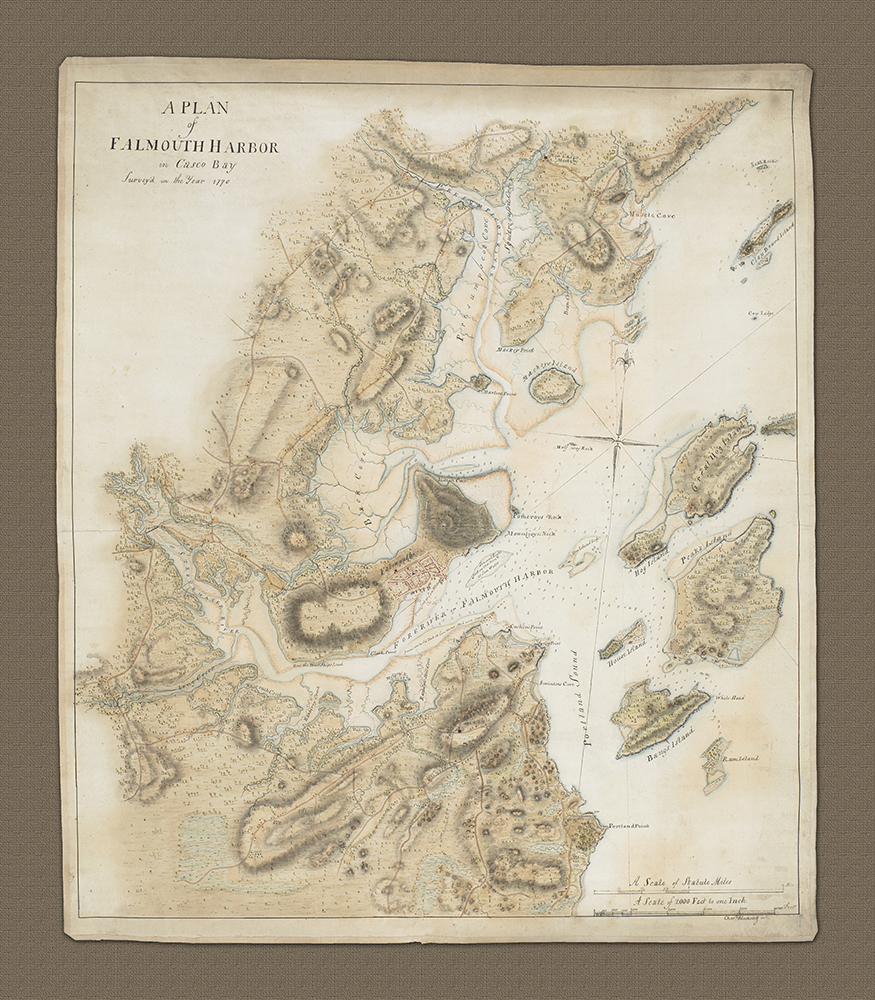The plan contains carefully deliniated detail including houses, important buildings, roads, topographic infoormation such as land relief, rivers and even soundings in the river and harbor. A scale of 2000 feet to the inch is shown.
After the end of the French Indian war in 1763 the British had scoured the coast looking for safe harbors for their fleet anywhere between New York and Halifax. They were also looking to secure the coastline from local smugglers and pirates.
The importance of Falmouth as a port and trading town was well understood by the British and in 1770 Samuel Holland, head of the British survey team tasked with the mamoth task of plotting the coastline briefly considered making Falmouth his headquarters but eventually opted for Portsmouth NH.
In the early days of the Revolutionary War, in May 1775 when the British army was under siege in Boston, local patriots in Falmouth captured several ships carrying supplies for Boston and weaponry from Fort Pownall at the mouth of the river. The British Vice-Admiral, Samuel Graves, then in charge of the Royal Navy supply chain to the troops in Boston, was under orders from his superiors (issued in July 1775 and received by him on October 4) to 'carry on such Operations upon the Sea Coasts ... as you shall judge most effective for suppressing ... the Rebellion.' Vice Admiral Graves ordered Captain Mowat to 'lay waste burn and destroy such Sea Port towns as are accessible to His Majesty's ships...'.
Mowat, Commander of HMS Canceaux, being by all accounts an amiable fellow, drafted a letter to the people of Falmouth (Portland) warning them of what was about to befall them, and offerd refuge for British Loyalists. In the course of the ensuing bombardment many buildings and houses were destroyed or damaged. In the harbor eleven small vessels were destroyed and four captured, and one man was killed and one wounded. Despite there being few direct casualties the townsfolk were left to fend for themselves for the winter, with no lodging, eating or housekeeping to be had in the town.
The aftermath of the raid proved very expensive for the British. With the overall cost of the loss put at about £50,000, news of the raid was met with outrage by Congress who resolved a recommendation that all provinces declare themselves self-governing and independent of British rule or influence, and that plans for a Continental Navy be advanced. Propagandists had a field-day citing cruelty and The Massachusetts Provincial Congress authorized the licensing of privateer actions against the British Navy, which was to be a thorn in the side of the British for years to come. The careers of both Graves and Mowat suffered as a consequence of the action.
The beautiful little survey of the town of Falmouth (now Portland) is dated 1770 and signed by Charles Blaskowitz, one of Samuel Holland's talented survey team working down the North American coast after the end of the French Indian war in as of 1764. The plan contains carefully deliniated detail including houses, important buildings, roads, topographic information such as land relief, rivers and even soundings in the river and harbor. A scale of 2000 feet to the inch is shown.


